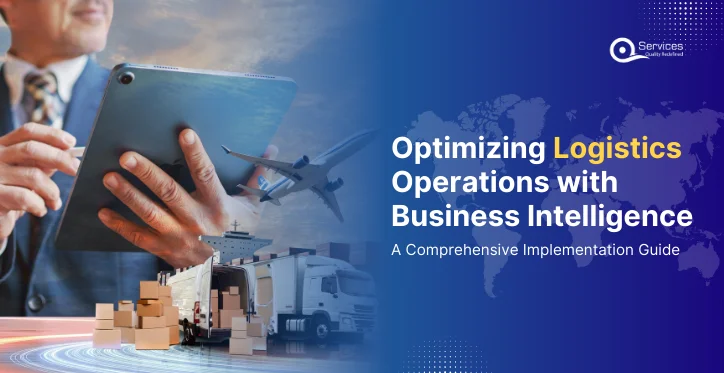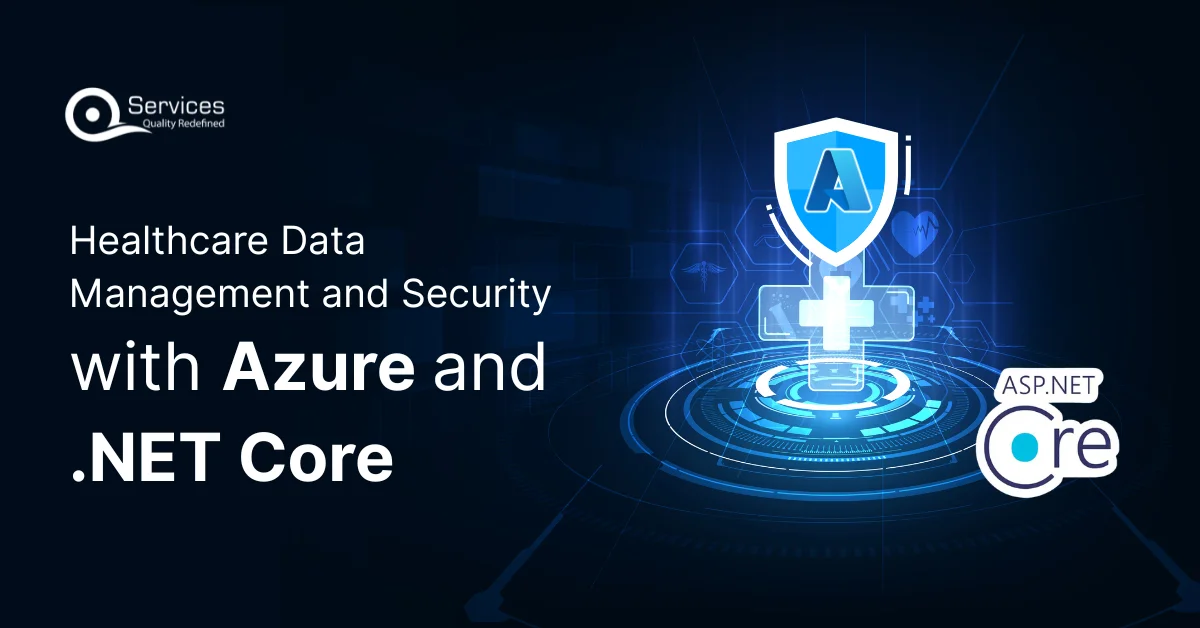
Rewards
.





CANADA
55 Village Center Place, Suite 307 Bldg 4287,
Mississauga ON L4Z 1V9, Canada
Certified Members:
.



Home » Optimizing Logistics Operations with Business Intelligence: A Comprehensive Implementation Guide

Logistics operations are in constantly under pressure as customer demands grow and the market changes quickly. So, how can businesses improve their operations? The answer is business intelligence in logistics. By using business intelligence for supply chain management, companies can streamline their processes, lower costs, and make decisions based on data that improve the supply chain.
BI plays a crucial role in logistics industry. Infact, it is a critical component of managing logistics operations that drives performance, reduces costs, and improves customer satisfaction. By using BI tools, logistics businesses gain real-time visibility of every part of their supply chain management.
The logistics industry has always been fast paced, but the demand for speed and efficiency has only grown. Without business intelligence logistics, companies are making decisions based on outdated or incomplete data. Business intelligence for supply chain provides the real-time data that logistics teams need to thrive in today’s competitive environment.
Slow Data Processing: Traditional methods of handling logistics data can slow operations. BI tools process data quickly, making it easier for teams to act fast.
Inadequate Visibility: Real-time business intelligence gives logistics teams the insights they need to see every aspect of their operations, improving visibility and transparency.
Increased Costs: By identifying inefficiencies and improving resource allocation, business intelligence in logistics helps reduce operational costs.
The ability to make decisions backed by business intelligence in supply chain management gives logistics companies a significant boost over competitors who rely on outdated methods.
Improving logistics with BI supply chain is not just about collecting data—it’s about using that data wisely to improve decision-making and efficiency. Let’s break down the four main components that make up business intelligence for logistics and how they can improve your supply chain and logistics operations.
Getting the correct data is the first step toward successful logistics. From inventory tracking to delivery monitoring, gathering right data from every part of the process is essential for building a strong BI system.
Statista found that businesses with poor data quality face lower profitability and operational issues. It is crucial to gather the right data to build a successful supply chain.
Once the data is collected, analytics tools turn raw data into insights, helping businesses spot issues, improve processes, and cut costs by 10-15%.
With the utilization of dashboards you can get an instant, visual overview of your supply chain’s health, showing key metrics, helping you make decisions in real time.
These dashboards allow you to keep an eye on logistics operations management in real-time for smooth functioning of your operations. They are really helpful for real-time business intelligence in supply chain analytics.
Predictive models use past data to predict future events. This helps you prepare for things like demand spikes or delays and adjust your logistics strategy accordingly.
A study by MIT Sloan found that businesses using predictive analytics see better decision-making and operational results. That’s why predictive models are so important for business intelligence in supply chain operations.
Use data, analytics tools, dashboards, and predictive models to streamline logistics with real-time insights.
In the next section, we’ll show you how to implement these strategies step by step to get the best results.
Optimizing your logistics operations with business intelligence (BI) can greatly improve efficiency and save costs. But how do you successfully bring BI into your logistics operations? This guide will take you through a simple, easy-to-follow process for using BI to make your supply chain smarter and more efficient.
Before jumping into business intelligence in logistics, the first and foremost step to assess your current logistics operations. Look at what’s working well and where there might be room for improvement. Are there parts of your logistic operations that slow things down or increase costs?
Start by evaluating processes like inventory management, transportation routes, or order fulfilment. Ask yourself: What can be improved? Understanding where your logistics processes need help will give you the right focus for using BI tools to make improvements.
Once you know where your operations need improvement, it’s time to set some goals. These are called Key Performance Indicators (KPIs). KPIs help you track important parts of your logistics business intelligence efforts, such as delivery times, cost per mile, and customer satisfaction.
By choosing the right KPIs, you can track how your business intelligence supply chain tools are working. This will help you see how your operations are improving.
Finding the best business intelligence tools is the key to make your logistics operations smarter. There are many BI tools out there, so pick one that fits your needs. It should be easy to use, work well with your current systems, and help you understand your data.
Look for tools that can connect with your existing supply chain business intelligence systems, like your warehouse management system or ERP. Popular tools like Power BI or Tableau can give you clear; real-time data that helps you make better decisions about your logistics.
To get the most out of business intelligence in supply chain, you need to combine all your data into one system. This means connecting data from your warehouse, transportation, and inventory systems into one BI platform.
When you integrate your logistics and operations data, you get a full picture of how your entire supply chain works. This helps you make smarter decisions.
The true power of business intelligence in logistics comes with predictive analytics. Predictive analytics uses data to forecast what will happen in the future. This can help you plan better, save money, and avoid surprises.
For instance, by analyzing past data, you can predict demand for certain products, optimize delivery routes, and even avoid delays. This reduces costs and speeds up your operations. Predictive analytics in logistics and transportation allows you to stay ahead of any issues, making your logistics system more reliable and cost-efficient.
Incorporating business intelligence for supply chain management isn’t just about using cool technology—it’s about making better decisions with data. With the right business intelligence tools, you can manage your logistics operations more efficiently, reduce costs, and keep your customers happy.
Get free Consultation and let us know your project idea to turn into an amazing digital product.

Real-time analytics makes logistics way easier. You can monitor shipments as they happen, react in real time, and fix potential problems before they even show up.
Let’s see, How can real time analytics help your business?
Real-time data helps you make quick decisions. If there’s a problem, like a shipment delay or low stock, you’ll know about it right away and can take action immediately.
Have you ever faced an issue that could’ve been solved quicker? With real-time analytics, you can address problems before they grow.
With real-time tracking, you can see exactly what’s in your warehouse and where it’s going. This lets you avoid running out of stock and keeps everything on track for future orders.
How often do stockouts impact your business? Real-time monitoring can help you avoid this issue completely.
Real-time tracking keeps deliveries on schedule and customers satisfied.
Want your customers to always get their orders on time? Real-time tracking makes it happen.
With real-time insights, you’ll know if there’s a problem on the horizon—whether it’s a truck delay or an inventory shortage—and you can fix it before it becomes a big issue. This keeps everything running smoothly.
Wouldn’t it be great to catch problems before they happen? Real-time data lets you do just that.
Ready to make logistics easier? Embrace real-time analytics, and you’ll see your operations improve quickly. With real-time data, you’ll solve problems faster, improve deliveries, and keep your customers happy.
If you’re managing logistics, you know that every decision matters. The good news is that business intelligence in supply chain gives you useful tools to help.
Using BI for supply chain can find the best routes for your deliveries by looking at real-time data, reducing cost on fuel and delivering goods.
With business intelligence in logistics, you can keep track of your inventory more easily. You’ll always know what you have in stock, preventing shortages or overstocking. Does it sound like something that could make your job easier?
Using real-time business intelligence in supply chain analytics makes order fulfilment quicker. Automating tasks cuts down on errors and speeds up delivery times, so customers get their orders faster.
Leveraging predictive analytics with business intelligence can forecast future demand and adjust your strategy ahead of time.
Adopting business intelligence in logistics could be a game changer for your business. But how do you know if it’s actually working? Whether you’re streamlining your logistics operations or improving your supply chain business intelligence, measuring success is key to ensuring you’re on the right track. But what should you measure, and how can you tell if the investment is truly paying off?
Here are some practical ways to assess the effectiveness of your business intelligence for supply chain:
One of the first indicators of success is whether business intelligence logistics tools are driving down operational costs. Have your transportation and warehouse expenses decreased? Are you seeing more efficient route planning? Tracking cost reductions is a clear sign that your business intelligence system is working effectively.
Business intelligence for supply chain isn’t just about cutting costs—it’s also about improving the speed and accuracy of operations. Are your teams able to process orders faster? Is inventory management running smoothly? If you see quicker turnarounds and fewer bottlenecks in your logistics operations, that’s a strong sign your tools are making an impact.
Is your supply chain handling disruptions better than before? Enhancing supply chain resilience with business intelligence lets you foresee challenges early, providing more time to adjust and recover faster when setbacks occur.
Another key measure of success is how quickly you can make decisions with real-time business intelligence. Can your team access up-to-the-minute data to adjust logistics strategies on the fly? If decision-making has become more data-driven and faster, it’s a sign that your business intelligence logistics tools are adding value.
At the end of the day, your customers are the best indicator of how well your logistics are performing. Are their orders arriving quicker? Are you providing better service with fewer mistakes? By tracking customer feedback and satisfaction, you’ll have a clear view of how your supply chain business intelligence is helping meet their expectations.
Share your project idea with us. Together, we’ll transform your vision into an exceptional digital product!

Using business intelligence to improve your logistics operations not only makes your work more efficient but also helps your business stay competitive. With QServices as your Microsoft Solution Partner, we can help you implement the best tools and strategies to improve your logistics. Contact us today to start making your operations more efficient and successful.
BI helps logistics companies gain insights into their operations, identify inefficiencies, reduce costs, and improve customer satisfaction by making data-driven decisions.
Key components include data integration, data warehousing, data visualization, reporting, and advanced analytics.
Common data sources include transportation management systems (TMS), warehouse management systems (WMS), enterprise resource planning (ERP) systems, GPS tracking, and IoT devices.
Data integration involves using ETL (Extract, Transform, Load) tools to collect data from various sources, transform it into a consistent format, and load it into a data warehouse.
Best practices include using clear and concise visuals, focusing on key metrics, and ensuring that the visuals are easily interpretable by stakeholders.
Common reports include shipment tracking, inventory levels, delivery performance, cost analysis, and customer satisfaction.
Reports can be customized by selecting relevant data fields, applying filters, and using visualization tools to create tailored dashboards and reports.
Comprehensive documentation, including user guides, tutorials, and API references, is available from the BI vendor.
Yes, online courses and certifications are available through platforms like Microsoft Learn and LinkedIn Learning.
BI solutions are highly scalable, allowing you to adjust resources based on your workload and business needs.

In the healthcare industry, managing and securing sensitive patient data is paramount. With the increasing adoption of cloud technologies, healthcare organizations are leveraging platforms like Microsoft Azure to store, process, and analyse healthcare data. However, with this shift comes the responsibility

The combination of Microsoft AI, Azure Health Insights, and Azure Cognitive Services is transforming healthcare by allowing smarter and efficient decision-making based on data. These technologies can fundamentally change the conventional practices of healthcare by taking new approaches to enhance

Healthcare is undergoing a massive shift thanks to new technologies. Think cloud computing, artificial intelligence (AI), and the tools developers use to build websites and apps. Hospitals and doctors’ offices are all trying to get better at caring for patients, running more smoothly, and keeping data safe. That’s why using Microsoft tech and Angular together has become a popular way to build modern, easy-to-use digital healthcare solutions.
Schedule a Customized Consultation. Shape Your Azure Roadmap with Expert Guidance and Strategies Tailored to Your Business Needs.
.





55 Village Center Place, Suite 307 Bldg 4287,
Mississauga ON L4Z 1V9, Canada
.




Founder and CEO

Chief Sales Officer

🎉 Thank you for your feedback! We appreciate it. 🙌